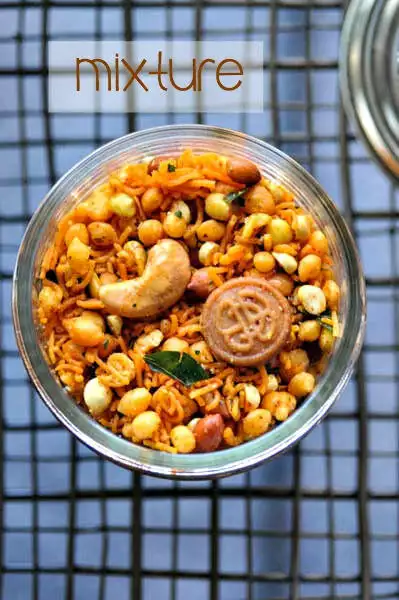
South Indian Mixture Recipe: Mixture is possibly one of the most popular evening snack recipe in India. There are many variations to the classic mixture recipe with different ingredients that can be added. This recipe is how we make Mixture at home and it has all the usual ingredients and a couple of our own additions. I hope homemade mixture makes an appearance in your Diwali snack list this year! Also check out my list of Diwali sweets recipes for a superb list of easy-to-make sweets this year.
My periamma (or bedhamma), Amma’s sister, is quite a wiz in the kitchen. Her cooking is very similar to my maternal grandmother’s and while my mom has the same style more or less, bedhamma is wonderfully consistent in her cooking. Her Diwali and festival snack recipes taste the same today as they did when I was 6 (and that was a while ago you guys). Whenever we go home to Kottayam, she’d show up to see us with a bagful of assorted homemade sweets and snacks. Her mixture is the best I have ever eaten, hands down so last year I requested her to make it with me so she came home late evening one day with small bagfuls of the required ingredients and her special mixture-making utensils.
Since she doesn’t have help, her technique is meant to be used for those who don’t have anyone around to help them hold the ladle while they pour the boondi batter, etc. She uses a large deep frying ladle which you can just hold under the oil and remove when done (pictured below). That way, there’s no need to scoop out individual anything out of the oil. A great technique, if you ask me, and saves a ton of time.
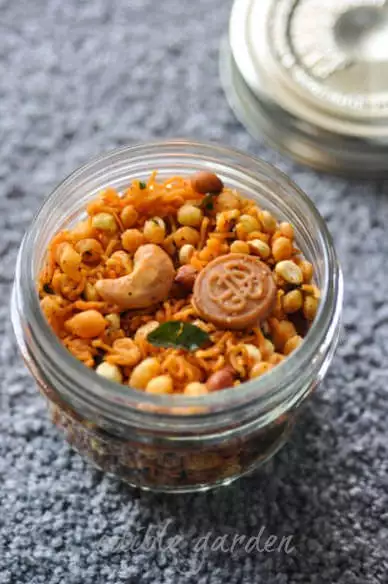
The South Indian mixture recipe from my childhood has always been this, spicy, lots of curry leaves, and also those small biscuits you snack on as a kid? They get added to the mixture as well. Since they are lightly fried and then added, they soak up the spices from the mixture and become hot and sweet. So good with tea or Milo! Usually they get picked out first and eaten, closely followed by the fried cashew nuts 😉
I don’t make a lot of snacks at home because it seems too much effort for the result and just for TH and I to enjoy. But Diwali is a special time and I can’t think of a more perfect time to try this South Indian mixture recipe for the first time and share with loved ones. You may also want to try making some kai murukku and thenkuzhal this festival season. Check out full list of Diwali snacks recipes here. You may also like this spicy boondi recipe, much easier and quicker to make than this South Indian mixture recipe.
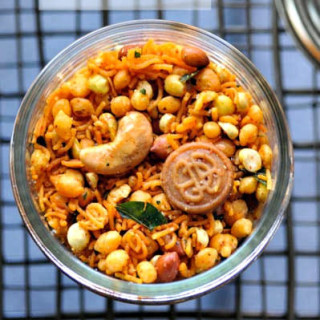
South Indian Mixture Recipe
Ingredients
- 250 grams of besan kadalai mavu
- 250 grams of raw peanuts
- 100 grams of roasted gram pottukadalai
- 2 big bunches of fresh curry leaves cleaned and dried completely
- 1/2 tsp of powdered hing asafoetida
- 1 tsp of chilli powder add more for spicier version
- 1/4 tsp of soda powder
- 1/2 tsp of sugar
- 2 cups of small round biscuits (optional)
- 1/4 cup of roasted cashew nuts optional
- Salt to taste
- Oil for deep frying
Instructions
- First, divide the total amount of besan into thirds. We will use the first 1/3 quantity of besan to make the sev for mixture.
For sev
- Add some salt to 1/3 of the besan and add enough water to make a thick dough like that of
- idiyappam
- Pass through a thin sev press into hot oil directly. Fry until golden brown, keeping the flame at medium heat.
- Drain and set aside.
For boondi
- Use the remaining 2/3 portion of reserved besan and add some salt and a generous pinch (about 1/4 tsp) of soda powder to this. Mix well and add enough water to make a loose batter like that of
- dosa batter
- Making sure that the oil is smoking hot, hold a boondi ladle over the oil and gently pour a thin layer of batter into the ladle.
- Do not tap or move the ladle too much, otherwise the boondis will lose shape. If the boondies are not perfectly round, that means the consistency of the batter is wrong. If you get flat boondi, then the batter is too watery so add a bit more besan. If you get tailed boondi, then your batter needs more water so adjust accordingly.
- Fry the boondi until golden brown on medium heat and drain.
- Add to the sev that has been set aside.
Next, there are some assorted items to fry.
- Using a large slotted spoon, fry the peanuts, roasted gram, biscuits (if using), and curry leaves on medium-low heat.
- The peanuts need to get roasted properly, so make sure they are a dark brown
- The roasted gram won't change colour much so just fry for about a minute or so.
- The curry leaves will splutter and burst a bit so take care while doing this. It's better to fry with the leaves on the stalk so that it's easier to drain.
- Add all these fried items to the sev and boondi already made.
- While everything is still hot, add the chilli powder and hing.
- Mix together well and break up the sev and curry leaves into smaller pieces as you do so.
- Add the roasted cashew nuts at this stage too, if using.
- The ingredients should be mixed while hot itself. We did this on a large sheet of brown wax paper which also absorbed the excess oil.
- Transfer to a large bowl and let the mixture cool completely before storing in airtight containers.
Step by Step South Indian Mixture Recipe
First, divide the total amount of besan into thirds. We will use the first 1/3 quantity of besan to make the sev for mixture.
Add some salt to 1/3 of the besan and add enough water to make a thick dough like that of idiyappam. Pass through a thin sev press into hot oil directly. Fry until golden brown, keeping the flame at medium heat.
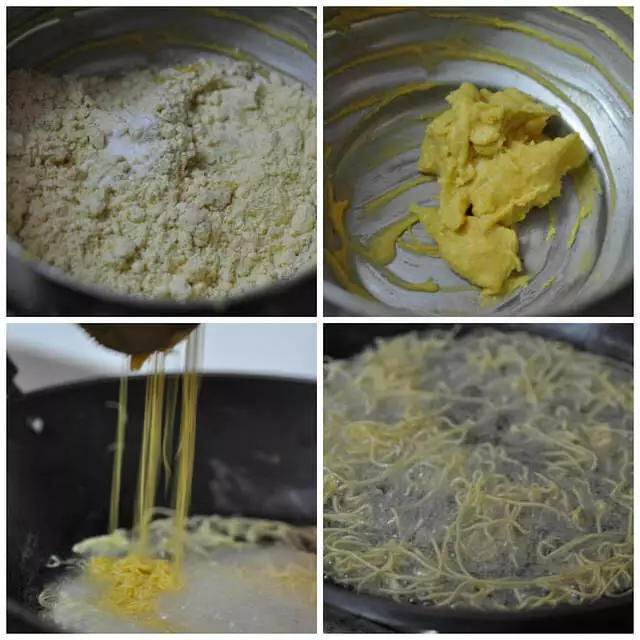
Drain and set aside.
Next step is to make the boondi. Use the remaining 2/3 portion of reserved besan and add some salt and a generous pinch (about 1/4 tsp) of soda powder to this. Mix well and add enough water to make a loose batter like that of dosa batter.
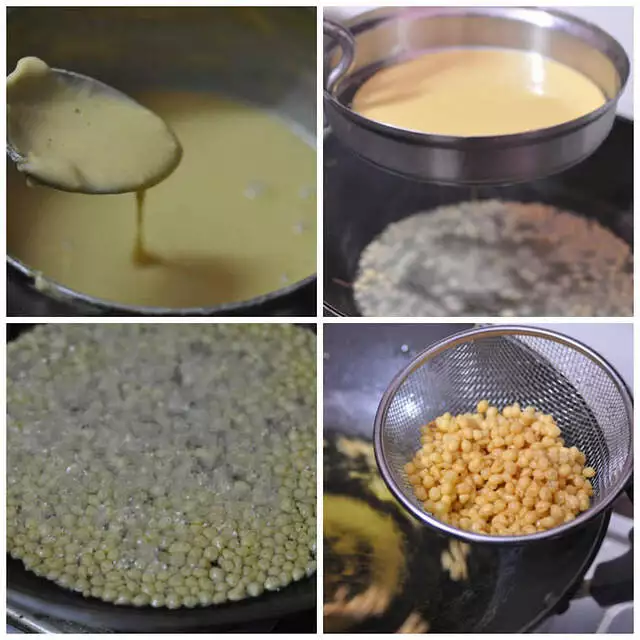
Making sure that the oil is smoking hot, hold a boondi ladle over the oil and gently pour a thin layer of batter into the ladle. Do not tap or move the ladle too much, otherwise the boondis will lose shape. If the boondies are not perfectly round, that means the consistency of the batter is wrong. Flat boondi means the batter is too watery so add a bit more besan. Tailed boondi means your batter needs more water so adjust accordingly.
Fry the boondi until golden brown on medium heat and drain. Add to the sev that has been set aside.
Next, there are some assorted items to fry. Using a large slotted spoon, fry the peanuts, roasted gram, biscuits (if using), and curry leaves on medium-low heat.
The peanuts need to get roasted properly, the roasted gram won’t change colour much so just fry for about a minute or so. The curry leaves will splutter and burst a bit so take care while doing this. It’s easier to fry with the leaves on the stalk so that it’s easier to drain. Individuals leaves will be very tough to drain after frying.
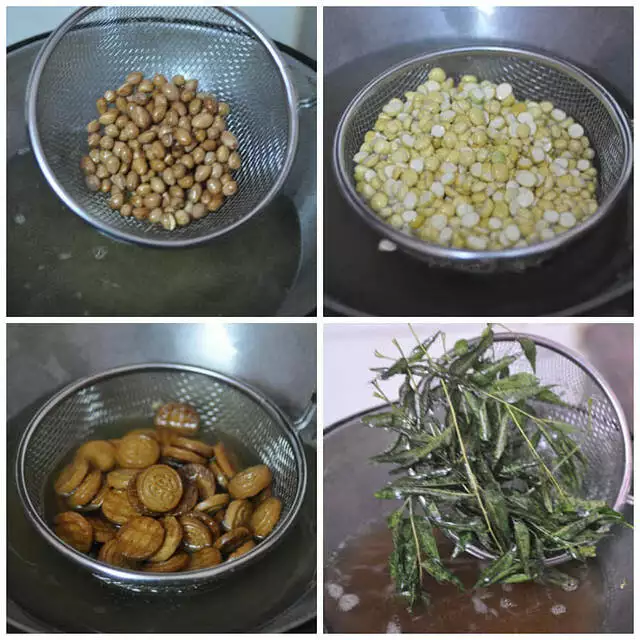
Add all these fried items to the sev and boondi already made. While everything is still hot, add the chilli powder and hing.
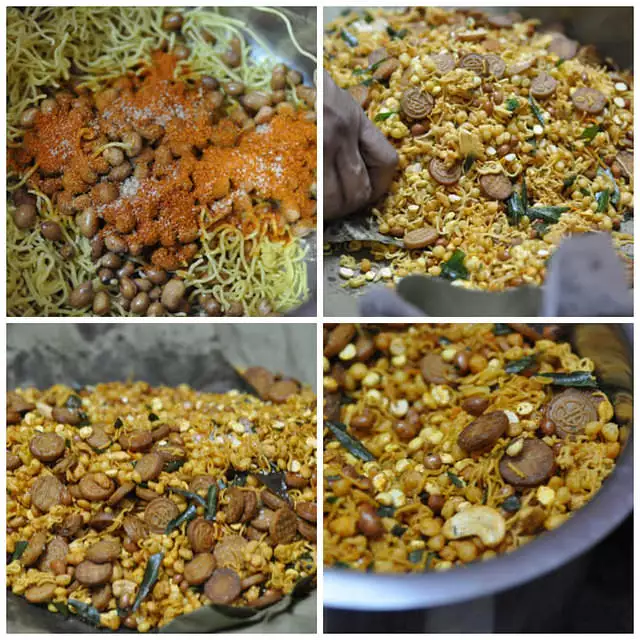
Mix together (it’s called South Indian mixture recipe after all, heh) well and break up the sev and curry leaves into smaller pieces as you do so. Add the roasted cashew nuts at this stage too, if using. The ingredients should be mixed while hot itself. We did this on a large sheet of brown wax paper which also absorbed the excess oil. Add salt and sugar at this stage too and test for spice level and saltiness while hot itself and add more of anything needed.
Transfer to a large bowl and let the mixture cool completely before storing in airtight containers. This is very important. If you close it when still hot, the moisture that gets trapped while it cools will make the mixture turn soggy.
This mixture keeps fresh in an airtight container for up to a week. Do drop me a note with picture if you make homemade mixture this year for Diwali and share with family and friends 🙂
For South Indian Mixture recipe in Tamil, Malayalam, Telugu, Kannada, Hindi, etc please use the Google translate button in the sidebar.

Hi very nice I am try on dipavali . wish u happy deepavali
thank you, do try and let me know!
Love mixture anytime.I forgot the name of those small biscuits ,can u tel me the name please?
hey sathya, i am actually not sure what they are called. all bakeries in kerala carry these though 🙂